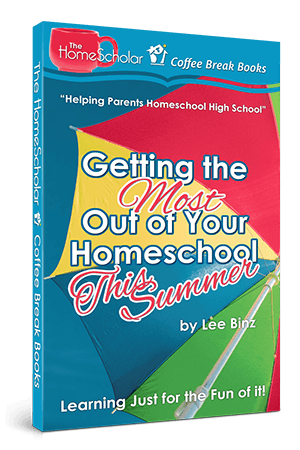~ A word from our founder, The HomeScholar Emeritus, Lee Binz ~
This is a chapter from my book, Getting the Most Out of Your Homeschool This Summer: Learning Just for the Fun of It! You can purchase a copy in print or Kindle version here.
Chapter 1
When to Take a Break
Summertime means different things to different homeschool families — some keep working right through the summer because they take breaks throughout the year, and others take the whole summer off because they’ve had their noses to the grindstone all year. When should you stop? How do you know? As with many homeschool decisions, it all depends on your family.
You’ll know your family needs a break if they are getting restless. If your children are starting to act up, they’re not cooperating the way they used to, and you’re seeing a bit more attitude, then those are signs it’s time for a break.
Course Completion
The completion of courses also signifies it’s time for a break. However, if you’re concerned that your child has not fully completed their science book, keep in mind how they handle this in both private and public schools. As long as students have finished 75 to 80 per cent of the textbook, they have completed the course for the year; they don’t have to consider it a failure at all. In the same way, if you have completed 75 per cent of what you set out to do, it’s okay for you to consider it done for the year.
When public and private school teachers begin the year, they often have the freedom to say, “I’m going to skip these two chapters” in a textbook so they can complete the course in one school year. Likewise, if your kids are getting restless, and you have completed 75 per cent of your curriculum, you can legitimately consider that course complete.
Another way to measure completion is using the number of hours required for a credit. If you have worked for one hour or more per day, or if you have 120 to 180 hours of work done in the subject, you can record that your child has earned the credit and is done for the year.
Often, the curriculum is so full of books, worksheets, and information that your child doesn’t finish in a year. This can also happen when a parent supplements or adds to the curriculum. If you are ready to be done for the year and your child has put in the time, you don’t need to continue working until your child has finished every assignment or book; you can simply call it complete.
Core Subjects
Some core subjects are easy to finish and others, such as math and science, take daily effort. When you fall behind in these subjects, it’s difficult to catch up. You can let non-core subjects drop when you are done for the year. In high school, instead of granting a whole credit, you can give your child a half credit for foreign language and stop for the year. Math is unique, though; I encourage you to work through the summer if necessary to finish at least 80 per cent of the math book. It will be more difficult to understand math the following year without finishing the book. Colleges want to see four credits of math. It’s important to teach a whole class each year.
Mastery
You can also base completion of courses on mastery of the concepts. Sometimes students already know some of the academic content without having read the textbook. If you give a test that demonstrates your student has mastery over a concept, such as a final exam or an SAT® or AP® exam, you can go ahead and consider that course finished.
Burnout
Your student’s enthusiasm and energy level can be a strong indicator of whether or not you’re done. If your child is still gung-ho and you can squeeze a little more study time out of them, then perhaps you can keep going for a few more weeks. If, however, your student is burnt out, you will be beating your head against the wall if you continue to press them for more.
The same is true of teacher burnout. If you as a teacher can barely tolerate homeschooling, it’s time to prioritize your mental health. If you have finished 75 per cent of the work and need a mental health break, it’s okay to call an end to study time.
Anger can sometimes become an issue, for both the child and the parent. It’s important to be honest with one another and acknowledge when there’s a problem. Pushing through when relationships are not going well typically leads to ineffective learning. If you find that student or teacher burnout or anger is making your homeschooling increasingly less effective, it’s best to take a break.
Natural Consequences
Sometimes kids simply don’t do the work needed during the school year. They don’t work enough, don’t put in the hours, and need to get that core class done. When this happens, summer school is a natural consequence of not getting their work done. Assign core subjects during the summer until the work is done. As your kid is working, make a plan to prevent the problem from happening again next year.
Remember my two big tips for schoolwork consistency next year. First, have a meeting with your child every day to check in on each subject and make sure they stay on task. Second, put weak areas first, so the subjects they are most likely to “forget” are done first each day.
Taking a break in the summer is important. Even if your child must take summer school classes at home, that doesn’t mean Mom or Dad needs to work, too. Have them work independently so you get a break from the normal rigors of homeschooling. Breaks are a breath of fresh air that can rejuvenate your homeschool next fall!
Alternatives
Taking a break is not an all-or-nothing situation. You don’t have to choose between schoolwork for eight hours every single day or stopping school and never touching a book or piece of paper for the summer. You can find a middle ground. You can stop working on English or spelling, but choose to keep working on math, especially when you are dealing with burnout.
Burnout stings like a sunburn. It aches like a pulled muscle. It stinks like a teenager after a weeklong mission trip. Stopping schoolwork, or some subjects, for a while may be the break you need to regroup and get ready to start anew later.
You’re the parent and you know your children and your situation. Make the choices that will serve your family best.
Getting the Most Out of Your Homeschool This Summer is one of my Coffee Break Books. What are Coffee Break Books? These are books designed for YOU – a busy homeschool parent feeling frustrated by something, and needing information NOW – all put together in an easy-to-read, short, simple format. Coffee Break Books are perfect for overwhelmed, sleep-deprived moms with a baby on their hip. Simple, large font makes them easy to read even when distracted or pulled in a million directions. They are designed to help parents tackle just ONE issue of homeschooling during just ONE coffee break! Each book combines a practical and friendly approach with detailed, easy-to-digest information. Never overwhelming, always accessible and manageable, each book in the series will give you the tools you need to tackle the tasks of homeschooling high school, one warm sip at a time.
Learn more about Getting the Most Out of Your Homeschool This Summer in my video review below!
This is a chapter from my book, Getting the Most Out of Your Homeschool This Summer: Learning Just for the Fun of It! You can purchase a copy in print or Kindle version here.






